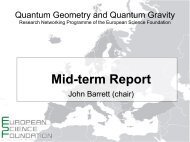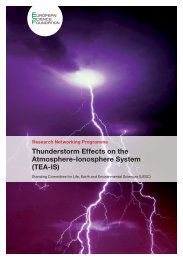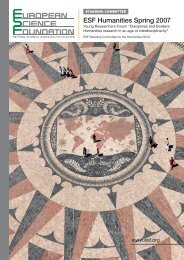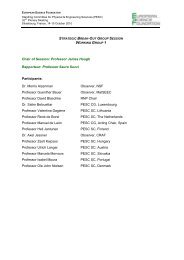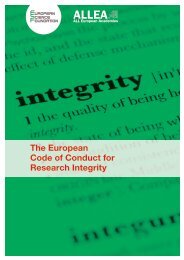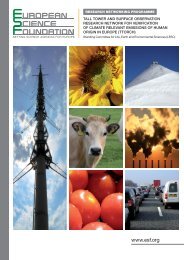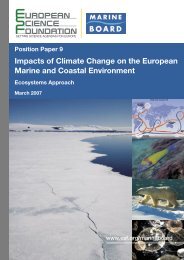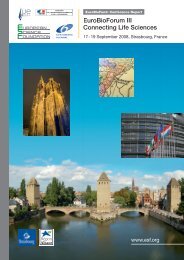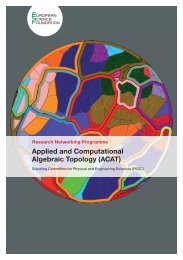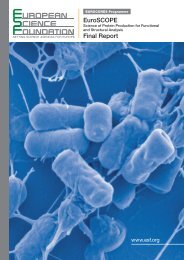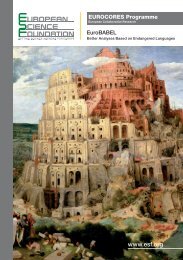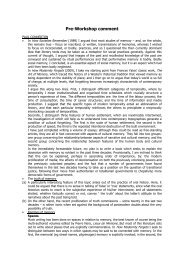European Peer Review Guide - European Science Foundation
European Peer Review Guide - European Science Foundation
European Peer Review Guide - European Science Foundation
You also want an ePaper? Increase the reach of your titles
YUMPU automatically turns print PDFs into web optimized ePapers that Google loves.
9.<br />
New Research Infrastructures<br />
Programmes<br />
l l l<br />
70 9.1 Purpose and scope<br />
<strong>European</strong> <strong>Peer</strong> <strong>Review</strong> <strong>Guide</strong><br />
This funding line is dedicated to supporting the<br />
creation of new Research Infrastructures (RIs).<br />
According to the definition of the <strong>European</strong> Strategy<br />
Forum on Research Infrastructures (ESFRI), RIs are<br />
defined as follows85:<br />
The term ‘research infrastructures’ refers to<br />
facilities, resources and related services used by the<br />
scientific community to conduct top-level research<br />
in their respective fields, ranging from social sciences<br />
to astronomy, genomics to nanotechnologies.<br />
Examples include singular large-scale research<br />
installations, collections, special habitats, libraries,<br />
databases, biological archives, clean rooms,<br />
integrated arrays of small research installations,<br />
high-capacity/high-speed communication networks,<br />
highly distributed capacity and capability computing<br />
facilities, data infrastructure, research vessels,<br />
satellite and aircraft observation facilities, coastal<br />
observatories, telescopes, synchrotrons and accelerators,<br />
networks of computing facilities, as well as<br />
infrastructural centres of competence which provide<br />
a service for the wider research community based<br />
on an assembly of techniques and know-how.<br />
RIs may be ‘single-sited’ (a single resource at a<br />
single location), ‘distributed’ (a network of distributed<br />
resources), or ‘virtual’ (the service is provided<br />
electronically).<br />
As a consequence of the EUROHORCs and ESF<br />
Vision on a Globally Competitive ERA and their Road<br />
Map for Actions86, an ESF Member Organisation<br />
85. See the website of the <strong>European</strong> Commission on research and<br />
infrastructures: http://ec.europa.eu/research/infrastructures/<br />
index_en.cfm?pg=what<br />
86. The Road Map can be downloaded at: http://www.esf.org/<br />
publications/science-policy-briefings.html<br />
Forum on Research Infrastructures was launched in<br />
particular for discussing and sharing best practice<br />
in funding and operating research infrastructures.<br />
Delegates from more than 30 member organisations<br />
and convened observers from the <strong>European</strong><br />
Commission, ERC, ERF, ESFRI and ALLEA work<br />
within this framework on a joint understanding<br />
of modern research infrastructures, with evaluation<br />
being a major focus. Readers of this chapter<br />
are strongly recommended to consult the dedicated<br />
MO Forum on Research Infrastructures for more<br />
specific information 87,88.<br />
Research infrastructures vary widely, not only<br />
in the scientific fields and communities they serve,<br />
but also in their organisational form, their size and<br />
– last but not least – their costs. There are probably<br />
almost as many ways of establishing a new research<br />
infrastructure as there are research infrastructures<br />
themselves.<br />
The ESFRI process, for instance, has foreseen an<br />
individual preparatory phase for each ESFRI project<br />
of typically two to four years to define the governance<br />
and legal model, the funding streams and the<br />
operational model. But the ESFRI roadmap contains<br />
only mature projects that have already been developed<br />
to a certain expected degree of maturity by the<br />
scientific community. Altogether it usually takes<br />
several, if not many, years from the original idea<br />
to the beginning of the construction phase. In the<br />
87. See http://www.esf.org/activities/mo-fora/researchinfrastructures.html;<br />
also see Swedish Research Council’s <strong>Guide</strong> to<br />
Infrastructure, 2007, 2nd edition, Stockholm.<br />
88. The support and development of <strong>European</strong> RIs is also the<br />
subject of the <strong>European</strong> Council Regulation, dated 25 June<br />
2009, entitled Community legal framework for <strong>European</strong> Research<br />
Infrastructure Consortium (ERIC) available at: http://eur-lex.<br />
europa.eu/LexUriServ/LexUriServ.do?uri=OJ:L:2009:206:0001:0<br />
008:EN:PDF



